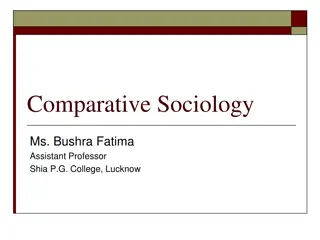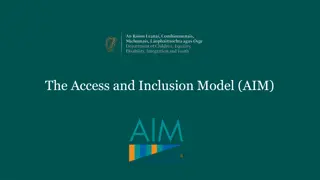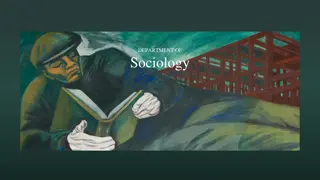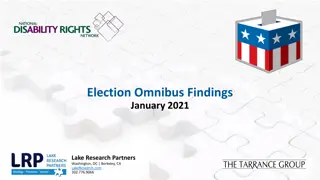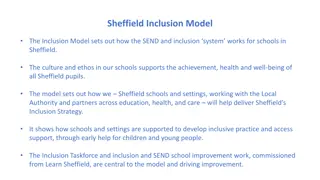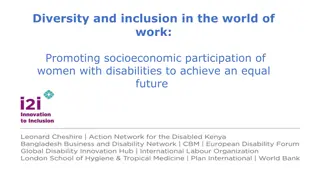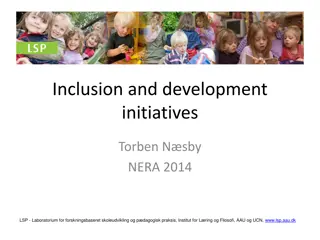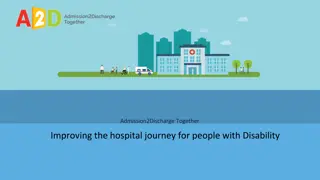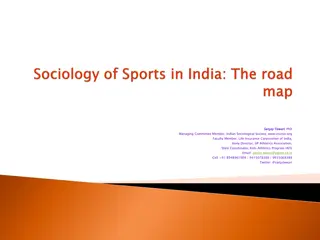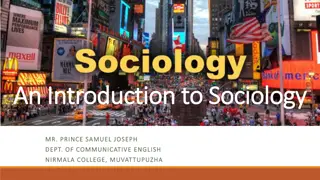Sociology of Sport: Understanding Disabilities and Inclusion
An exploration of the intersection between sports and disabilities, highlighting the challenges faced by individuals with impairments in participating fully in social and physical environments. The discussion delves into the concepts of impairments, disabilities, and handicaps, emphasizing the importance of accommodations and societal attitudes in enabling inclusivity. Issues such as inclusion in public schools, the impact of the Americans with Disabilities Act, and representations in sports media are addressed. The narrative sheds light on the experiences of individuals with disabilities in sports, advocating for equal opportunities and dismantling stereotypes.
Download Presentation

Please find below an Image/Link to download the presentation.
The content on the website is provided AS IS for your information and personal use only. It may not be sold, licensed, or shared on other websites without obtaining consent from the author.If you encounter any issues during the download, it is possible that the publisher has removed the file from their server.
You are allowed to download the files provided on this website for personal or commercial use, subject to the condition that they are used lawfully. All files are the property of their respective owners.
The content on the website is provided AS IS for your information and personal use only. It may not be sold, licensed, or shared on other websites without obtaining consent from the author.
E N D
Presentation Transcript
Chapter 9 Sociology of Sport
9.1. Were not handicapped: We just cant hear 9.2. How can I wear shoes if I don t have feet? 9.3. The hit isn t real unless it bends steel: Men & Murderball Social Class 9.4. Paying the price: The cost of sport prostheses 9.5. Tensions in the Olympic family: Siblings with disabilities 9.6. One of God s favorites : Religion and disability
An impairment exists when a person has a physical, sensory, or intellectual condition that potentially limits full participation in social and/or physical environments We re not handicapped: We just can t hear An impairment becomes a disability only when accommodations in social or physical contexts are not or cannot be made to allow the full participation of people with functional limitations. People become handicapped when others define them as inferior and unable due to perceived disabilities. Thus, disabilities and handicaps are the results of the following: Environments organized to meet only the needs of able-bodied people Norms (rules) that disadvantage people with impairments Attitudes and beliefs that equate particular impairments and disabilities with inferiority and inability.
Public schools are traditionally places where able-bodied young people develop and display their sports skills, but the myth that people with disabilities aren t interested in sports subverts opportunities for them. How can I wear shoes if I don t have feet? The Americans with Disabilities Act (ADA) of 1990 prohibits discrimination against individuals with disabilities in all areas of public life, including jobs, schools, transportation, and all public and private places that are open to the general public. in 2013 when the U.S. Department of Education published guidelines for including students with a disability into athletic programs. But there continues to be resistance to the guidelines and confusion about their meaning as school and athletic administrators claim that they have no resources to offer separate programs for students with a disability and little or no expertise for including those students in existing sports programs.
The hit isnt real unless it bends steel: Men & Murderball Murderball is a provocative documentary about athletes on the U.S. national men s wheelchair rugby team. For example, the United States Quad Rugby website (www.quadrugby.com) noted that Kyle Smith of the New York Post gave Murderballhis award for Best Argument for Not Pitying Quadriplegics. Representation issues will certainly be on the minds of viewers with disabilities.
Diane Cabrera discovered this when cancer took her leg. Her new prosthesis enabled her to walk, but it cost $11,000, and her HMO covered only $4000 per year Median earnings for people with no disability were $35,070 compared to the $23,006 median income reported for individuals with a disability Paying the price: The cost of sport prostheses Only 24 percent of people with disabilities (16 years and older) report that they work full or part-time, compared with 67 percent of people with no disability. People with a disability are twice as likely as people with no disability to live at or close to the poverty line.
Tensions in the Olympic family: Siblings with disabilities disability sport organizations that they could no longer use Olympic images at the Paralympics or the trials leading up to them. The flag, therefore, was not so much a flag as it was a licensed logo, and it could be used only by those who paid for the right to do so.
One of Gods favorites : Religion and disability Religious beliefs have long informed popular ideas and beliefs about bodies and embodied experiences, including experiences of disability. Although research on religious beliefs about the body is scarce, sociologists have frequently studied the norm of reciprocity in human interaction.


